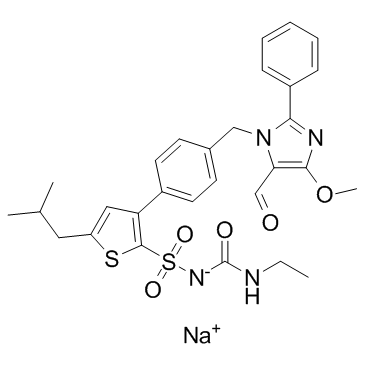| Description |
AVE 0991 sodium salt is a nonpeptide and orally active Ang-(1-7) receptor Mas agonist. AVE 0991 competes for high-affinity binding of [125I]-Ang-(1-7) to bovine aortic endothelial cell membranes with IC50 of 21±35 nM.
|
| Related Catalog |
|
| Target |
IC50: 21±35 nM (Ang-(1-7) receptor)[1]
|
| In Vitro |
AVE 0991 is a nonpeptide compound that evokes effects similar to Ang-(1-7) on the endothelium. AVE 0991 and unlabeled Ang-(1-7) compete for high-affinity binding of [125I]-Ang-(1-7) to bovine aortic endothelial cell membranes with IC50s of 21±35 and 220±280 nM, respectively. Peak concentrations of NO and O2- release by AVE 0991 sodium salt and Ang-(1-7) (both 10 μM) are not significantly different (NO: 295±20 and 270±25 nM; O2-: 18±2 and 20±4 nM). However, the released amount of bioactive NO is ≈5 times higher for AVE 0991 in comparison to Ang-(1-7)[1].
|
| In Vivo |
AVE 0991 (0.58 nmol/g) produces a significant decrease of water diuresis in WT mice compared with vehicle-treated animals (0.06±0.03 mL versus 0.27±0.05; n=9 for each group; P<0.01). The antidiuretic effect of AVE 0991 (AVE) is associated with an increase in urine osmolality (1669±231.0 mOsm/KgH2O versus 681.1±165.8 mOsm/KgH2O in vehicle-treated mice; P<0.01). The genetic deletion of Mas abolishes the antidiuretic effect of AVE 0991 during water loading (0.37±0.10 mL [n=9] versus 0.27±0.03 mL [n=11] in AVE 0991-treated mice). As observed with C57BL/6 mice, administration of AVE 0991 (0.58 nmol/g) in water-loaded Swiss mice also produces a significant decrease of the urinary volume compared with vehicle-treated animals (0.13±0.05 mL [n=16] versus 0.51±0.04 mL [n=40]; P<0.01)[2]. One week of treatment with AVE-0991 produces a significant decrease in perfusion pressure (56.55±0.86 vs. 68.73±0.69 mmHg in vehicle-treated rats) and an increase in systolic tension (11.40±0.05 vs. 9.84±0.15 g in vehicle-treated rats), rate of tension rise (+dT/dt; 184.30±0.50 vs. 155.20±1.97 g/s in vehicle-treated rats), rate of tension fall (−dT/dt; 179.60±1.39 vs. 150.80±2.42 g/s in vehicle-treated rats). A slight increase in heart rate (HR) is also observed (220.40±0.71 vs. 214.20±0.74 beats/min in vehicle-treated rats[3].
|
| Kinase Assay |
Binding of [125I]-Ang-(1-7) is performed. Briefly, 100 μg of membranes from primary cultured bovine aortic endothelial cells (BAECs, passage 1) are incubated in a total volume of 200 μL for 45 minutes at 25°C in HEPES-buffered saline (10 mM HEPES, 0.1 M NaCl, 5 mM MgCl2) containing 0.2% BSA and protease inhibitor cocktail Complete (Boehringer Mannheim). Saturable binding of [125I]-Ang-(1-7) is calculated by subtracting nonspecific binding (40% to 50%), determined in the presence of 10 μM unlabeled Ang-(1-7) from total binding. Competition experiments with increasing concentrations of AVE 0991 and unlabeled Ang-(1-7) are performed in the presence of 10 nM [125I]-Ang-(1-7). Assays are terminated by vacuum filtration (≤15 mm Hg) over Durapore filters (0.65 μm, Opak 96-well plates) presoaked with 1% BSA. The filters are washed 3 times with each 100 μL of PBS (50 mM, NaHPO4 and 0.15 M NaCl, pH 7.2). Radioactivity on dried filters is quantified with a gamma counter[1].
|
| Animal Admin |
Mice[2] Swiss male mice, Mas-KO (Mas-/-) male mice on the pure genetic background C57BL/6, and WT C57BL/6 control mice (Mas+/+) are used. Water diuresis is induced by intraperitoneal water injection (0.05 mL/g of body weight [BW]) in conscious mice. Drugs are administered in the same injection with water load at prefixed volumes (0.01 mL/g BW). In the first set of experiments, WT mice (C57BL/6, control group) or Mas-KO mice are treated with: (1) 0.58 nmol/g AVE 0991 (n=9, control; n=11, Mas-KO mice); or (2) vehicle for AVE 0991 (10 μM KOH, 0.01 mL/g; n=9, control; n=9, Mas-KO). In the second set, Swiss mice are treated with: (1) vehicle (n=36); (2) 0.58 nmol/g AVE 0991 (n=16); (3) 46 pmol/g Ang-(1-7) antagonist A-779 (n=4); (4) 2 nmol/g losartan or valsartan (n=5); (5) 2 nmol/g AT2 receptor antagonists PD123319 or PD123177 (n=9); (6) AVE 0991 combined with A-779; (7) AVE 0991 combined with losartan or valsartan (n=4 for each); (8) or AVE 0991combined with PD123319 (n=5) or PD123177 (n=4). The urinary volume is measured for 60 minutes after water loading, and urine samples are obtained to determine the osmolality. The dose of AVE 0991is based in preliminary experiments performed in Swiss mice. Rats[3] Male Wistar rats weighting 250-300 g are used. Rats are treated either with AVE-0991 (1 mg/kg, n=9) or vehicle (0.9% NaCl, n=11) administered orally by gavage. At the end of the 7 day period of AVE-0991 treatment, the animals are decapitated 10-15 min after intraperitoneal injection of 400 IU of heparin. After the thorax is opened, the heart is carefully dissected, removed from the thoracic cavity, and placed in a plate containing ice-cold Krebs-Ringer solution (KRS) to attenuate any potential cardiac damage during dissection of aorta artery.
|
| References |
[1]. Wiemer G, et al. AVE 0991, a nonpeptide mimic of the effects of angiotensin-(1-7) on the endothelium. Hypertension. 2002 Dec;40(6):847-52. [2]. Pinheiro SV, et al. Nonpeptide AVE 0991 is an angiotensin-(1-7) receptor Mas agonist in the mouse kidney. Hypertension. 2004 Oct;44(4):490-6. [3]. Ferreira AJ, et al. The nonpeptide angiotensin-(1-7) receptor Mas agonist AVE-0991 attenuates heart failure induced by myocardial infarction. Am J Physiol Heart Circ Physiol. 2007 Feb;292(2):H1113-9.
|
